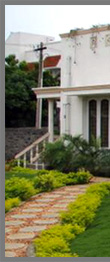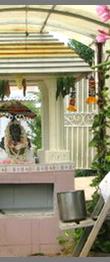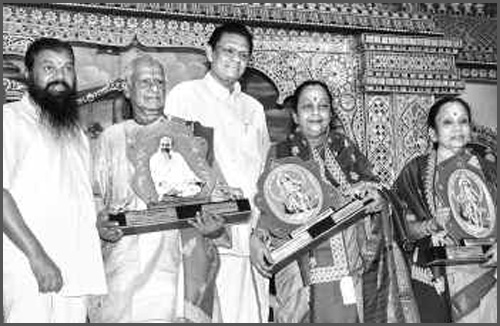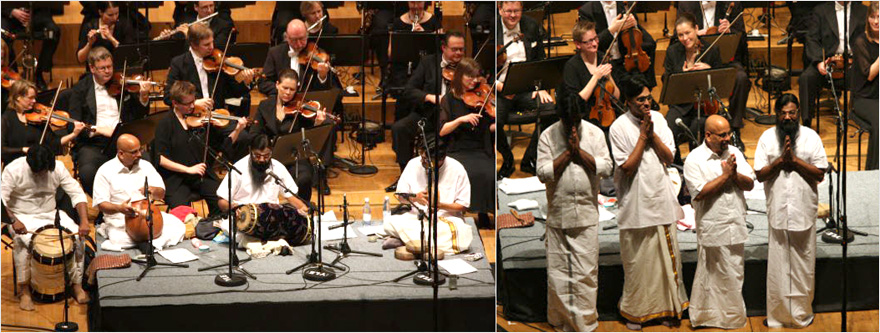|
|
| 'Like' us on Facebook | Follow us: |
Posted on : Jul 06, 2014
GOD'S MESSENGER FOR MRIDANGAM
- a Conversation with Guruji Kaaraikkudi Mani
Part-2
BP: You have set up a Gurukulam, a rather unique concept in the modern times. Can you tell us something about that?
GKM: I started the Gurukulam in Chennai in East Coast Road, in a place called Panaiyur near the seashore. It is called ‘Sea-sun Gurukulam’. The spelling is different – SEASUN, not SEASON. It denotes ‘near the sea, under the sun’. There's a reason for choosing this name.
It has been my long-cherished dream to have students stay in the school and learn – stay, study, and shine. That's how the students of today can learn about the discipline of the old days.
 |
 |
 |
 |
 |
 |
 |
 |
| Guru Kaaraikkudi Mani's "Seasun Gurukulam" off East Coast road near the seashore at Panaiyur, Chennai. It consists of guestrooms, classroom, common kitchen and music library for learners. The intensity of the program normally consists of weekend study, daily classes, and field exercises. The motto behind the gurukalam is Stay, Study and Shine |
|||||||
There is no fixed schedule in these schools. I sometimes wake the students up at 5 in the morning and teach them. Sometimes I train them after lunch, in the afternoon. At times, I even teach them after 9.30 in the night. There is no time bar. So the students are ever alert, eagerly waiting for me to teach them.
Students must yearn for music. They must long for the chance to learn music. Only then will the students realize the value of music. There is no point if that yearning is not there. In my small way I'm trying to implement this. I'm happy that we are able to teach at least a few students this way. We give them free boarding and lodging, and also pocket money!
BP: You teach them? Or you have other teachers?
GKM: My senior students teach there. I also frequently teach. And I am certainly happy about this as it is said that one must not publicise the charity that one does. At the same time, the music that one knows must be shared with as many people as possible. Whatever one knows must be taught to others. When we teach, we learn better. We are all still in the learning process.
I adopt different teaching methods for different students. Based on the capacity of a student, the hand position and so on, I choose a style. I might have to use a completely different style for another student. When a student does not understand, I learn a new way of teaching him. Thus whenever I teach, I am also learning.
BP: As a child, you initially learnt vocal music. And then, you switched over to mridangam. Why mridangam? What really attracted you to mridangam?
GKM: The credit for that goes to my father.
I started singing at the age of three or four. I used to sing the Pancharatna Kritis composed by Thyagaraja Swami. By the age of six, my schedule was like this: I woke up by 5 a.m. My singing practice would begin by 5.15 a.m. for about 45 minutes. The next 45 minutes was for practising mridangam and another 45 minutes for school studies. Only then I would be given coffee. I used to follow the same schedule in the evening too. By 8 p.m., I would have dinner and go off to bed.
If I did this for a week, my father would give me a few paise, and I would purchase movie tickets with it. At that time I followed this schedule so that I could watch movies. My father being a teacher was very strict.
Here I would like to mention something. The Karaikudi Belt is also known as the Chettinad Belt. The deity from our local temple used to be brought out in a procession along the various streets. And Nadaswaram and Tavil players used to perform on the road in front of the deity. There would be about 100-200 people surrounding these artists, who played for over an hour with so much focus.
As I was a small boy and could not see them all in that crowd, my father would lift me onto his shoulder. When the Nadaswaram player performed, I would just listen. But when the Tavil player started, I too would start playing on my father's head. And I used to play the right rhythm just like the Tavil player. That's when my father realized my innate knowledge and talent in rhythm! The very next day after one such procession, he put me in a class with my first teacher, Karaikudi Rangu Iyengar.
That was also quite interesting. I must have attended the class for just 10 days or so. My teacher lived in the first floor and we were in the ground floor. While children played with marbles, I would listen to the sounds of mridangam from the upper storey. I would observe that, go home, and practise. The next day, I'd come back, play and show it to my teacher. The knowledge of rhythm was inherent in me. I found it very easy to learn rhythm patterns at that young age. Thus I started playing for concerts at the age of four. That's how I took to the mridangam.
 |
|
| Vocalists Bombay sisters, C. Saroja and C. Lalitha and mridangam exponent, Madurai T. Srinivasan with the awards presented by the Sruthi Laya Kendra in Chennai. Others from left: The Kendra founder, Karaikudi R. Mani and the CPCL director, Sabaretna. — Photo: K.V. Srinivasan |
BP: When you were eight years, you gave your first performance. And you got the National Award from the President when you were eighteen. Then again, for the next 40 years, you didn't accept any award. What was the reason?
GKM: Are you sure that awards are going to genuine people now? No. Political and bureaucratic influence is immense. So I keep away from awards.
Awards must come in search of a person, not the other way around.
BP: In fact, that's the way you give your awards in the Winter Festival that you conduct; you search for talent.
GKM: Yes. We give awards only to deserving people; they are not based on popularity. I select about ten to twelve people, write their names on little pieces of paper, and place it in my Guruji's shrine. I then ask a young child to pick up a chit. That's how the awardees are chosen.
So it's prasadam, not an award!
BP: I read about a wonderful thing that you do for aged musicians. You try to support them through the earnings during the Winter Festival. How did this idea come about? It's such a beautiful gesture.
GKM: Well, some organizations do give similar awards. For example, they might choose a senior musician on the opening day of a festival, and honour that person by conferring a title like ‘Acharya’.
You see, the aged musicians can no longer sing or play. They'll definitely have a small thought on their minds – “We used to perform about 20 years ago. But now, we are unable to do so.”
Just to show our support and respect for them, we call them and honour them by offering whatever help we can. Actually, it is not help. The senior musicians are very well off. It's just our way of showing our respect for them and telling them that we have not forgotten them.
Also, the entry fee that we charge is nominal and affordable.
BP: In 1984, you started Sruthi Laya, your music school. What prompted you to go into this endeavour?
GKM: Palghat Mani Iyer is considered our ‘Rhythm God’. He earned the mridangam its status. Today if you are interviewing an mridangam artist, it is because of his efforts.
In those days, Palghat Mani Iyer used to play three thani aavarthanams (solo percussion), each one for about five minutes. When he would begin, people who stood outside would come inside to hear him play. After his era, during the thani aavarthanams, people started going out from the auditorium to relax. This kind of an attitude pained me.
Moreover, the mridangam occupies the third place in a concert – its vocal, violin, mridangam. I wanted to bring the mridangam to the forefront and make its player occupy the centre stage. This was what prompted me to conceptualise Sruthi Laya, which refers to the combination of Sruthi (tune) and Laya (rhythm).
 |
 |
 |
 |
 |
 |
 |
 |
| The 'Shanmukha' Band of Guruji: B Suresh (Ghatam), V P Raju (Mandolin), B V Raghavendra Rao (Electric Violin), V B Balasai (Bamboo keyflute) and V P Madhusudhan (Tabla, djembe) |
|||||||
Initially, when we started this concept, the mridangam player would occupy the centre of the stage and melody instruments would be on the side. The thani aavarthanam would be the main part.
As an interlude for this, I composed a musical piece on my own.
In the next stage, I made thani aavarthanam as a separate part by itself. I played the thani aavarthanam for 45 minutes on the stage. You see, a singer or instrumentalist can choose or set the tempo. The raga is also his/her choice. The mridangam used to be an extension of this choice. But, here I would play a thalam (beat) as per my choice. I set the tempo to my convenience. So for 45 minutes, I used to play thani aavarthanam, then there used to be a 10-minute interval, and later, I used to accompany somebody for two hours. That accompaniment would not have any thani aavarthanam.
We established this kind of a concept for three years. But what happened then was that those who listened during the thani aavarthanam would get up and leave as soon as the mridamgam became an accompanying instrument! So most artists were not very comfortable with this idea. So we discontinued it. Shruti Laya was started based on the concept that people should not get up and leave during thani aavarthanam. I've been successful in that effort.
I wanted to create awareness by performing 27 concerts. There are 27 birth stars or Nakshatras according to Indian tradition. For every star, there is a Beejaakshara Mantra. I used to pray before each concert that the vibes should reach all the people of the particular star of that day. My Guru taught me this.
 |
|
I played 33 concerts in the most important places. After that, I stopped this because I'd achieved what I wanted to.
Only after that, I made a CD. Before that, nobody had performed a thani aavarthanam for an entire CD. There had been a few attempts earlier, but the concept hadn't become so popular. Hence, after I started this concept, many senior artists started releasing CDs that contained full thani aavarthanams.
There is a Tamil poem in my album ‘Amrutham’, which means,
If you get the inner vision called Guru,
you will get the knowledge of Laya.
A Tala is the measure of that silence hidden in every music. There is tala in the lashing of the waves, the changing faces of the moon and even in moving planets.
In fact, there is no music without a Guru. There is no art without a Guru. And there is no music without Laya.
There is no concert without a mridangam. My idea is to take the mridangam to a higher pedestal and offer it to the world.
BP: With this concept, you've travelled to many countries. And then, you've allowed a lot of fusion music also to come into Carnatic music.
You're one who is so devoted to Carnatic music. And as you said, sometimes, Western music doesn't give that exalted status to music in some of its music forms. So, initially, was it a hesitation for you to accept the Western kind of music?
You have travelled and met many international musicians, and collaborated with so many of them in Finland, Italy, with Paul Simon in USA and so on. And all these musicians have a different genre of music. So how was your experience in making fusion music? Did you really like it in the beginning?
GKM: I have never lived under compulsion, even in my personal life. For example, when it comes to music, jazz has its own style, similarly Western classical music has its style. ‘How is that related to our music?’ is the question.
We have to first study their music. They should also learn about our music – the nuances and the permutations/combinations. After that, with a good level of understanding and the required practice, we can arrive at a good shape after retaining the parts that sound very good and eliminating those that do not sound so good. When music is thus played, it acquires a new colour. That is how I perceive fusion.
In Australia, there is an organisation called Australian Art Orchestra. I've been playing there for more than 15 years now. In that institute, a trombone player learns mridangam. He is a member of the Australian Art Orchestra. When he happened to come to India, he heard Indian music and wanted to play the same.
.jpg) |
| Guru Kaaraikkudi Mani was the pioneer in bringing Mridangam to the centre stage. He also gave a new dimension when he fusioned Mridangam with other traditional Indian instruments as well as western music |
A student of mine in Australia made him listen to the first Shrutilaya piece that I played in raag Bahudari Ranjani. After listening to the entire CD, he realized that this song was very suitable for jazz too.
I did not play it for the jazz style. I played it according to the rules of Carnatic music. But it is suitable for jazz. Thus there is scope for one style of music to become suitable for another. This led to the album ‘Into the Fire’. This is how I began associating with fusion music.
Similarly in Finland, I have played with the 110-member Philharmonic Orchestra and then the 118-member Symphony Orchestra. There is a famous composer there named Aero. He often visits India. He listens to many of our concerts. In fact, he has not missed even one of my concerts. He met me once and requested me to come to Finland and play.
First he had asked me to play only the thaala vaadhyam. Then later, he composed a piece in the Indian pattern. He said there would be an aalap first by the Philharmonic Orchestra, followed by a theme, similar to a Pallavi, and then a dialogue by him. He said that he'd work on it further if I agreed to play. I agreed.
 |
| Guruji's desire to present innovative rhythmic ideologies led him to set up the Sruthi Laya percussion ensemble which was supported by a large orchestra; he gave importance to taalavadya concerts. |
He worked on it and then gave it the name Layapriya, which happens to be the name of my house. This is how my association with fusion music developed further. Now I am involved in many workshops with Western musicians. I've done this 4-5 times at the Griffith University in Brisbane and at the Victorian College of the Arts in Melbourne. I have associated with so many musicians. All of them are so amazed at the various nuances and potential of Indian music.
Initially when I started playing with these musicians, they used to make note of the rhythm notations, and the gaps in their way. But now, if I indicate 3 Kaarvais, they just note it as 3, and so on. It has become easy for them.
Once they become familiar with our music, they find it easier to understand their own music too. Hence, there's nothing wrong about fusion music. It's just that the blending has to be done in an appropriate way. One should not do it just for the sake of doing fusion.
BP: So would you like to make more of such fusion music?
GKM: Of course! While working on a project with Paul Simon, he recorded my rhythm alone for 8 hours. Then he wrote lyrics for this rhythm and composed the tune. Thus my desire to make rhythm occupy the first place got fulfilled.
BP: Fantastic! You're really God's gift to mridangam.
 |
 |
 |
 |
 |
 |
 |
 |
| Guruji with American musician and singer-songwriter Paul Simon | |||||||
GKM: There is a phrase ‘Veena, Venu, Mridangam’. Among instruments, only these three have been played by God. I used to jokingly say that Saraswathi has taken the Veena, Krishna has taken the flute, while Nandi and Lord Shiva have taken the mridangam. The remaining art forms, be it vocal or the other instruments, God has sent them down to earth for human beings to pursue.
Mridangam is a divine instrument. We can do wonders with it if we handle the instrument properly!
What do you think about this Article? Please let us know by writing in to h2h@radiosai.org. Do not forget to mention your name and country.
- Team Radio Sai









